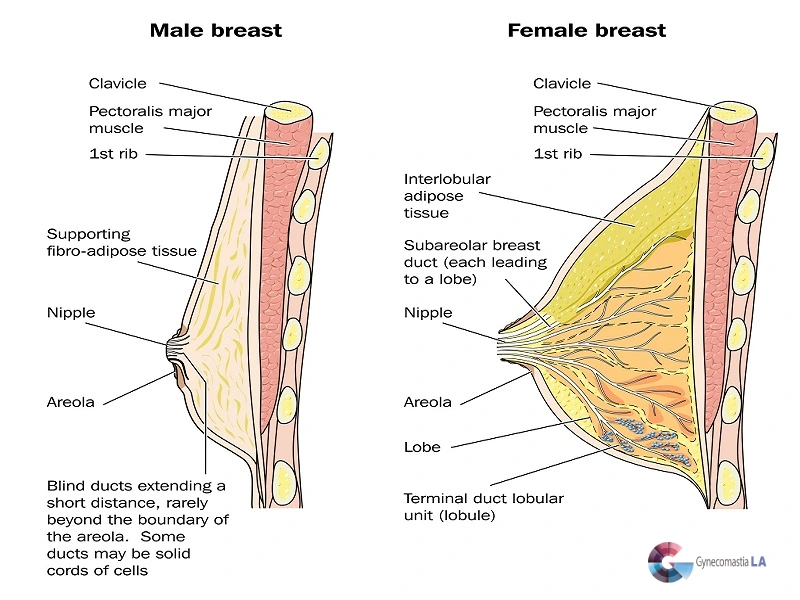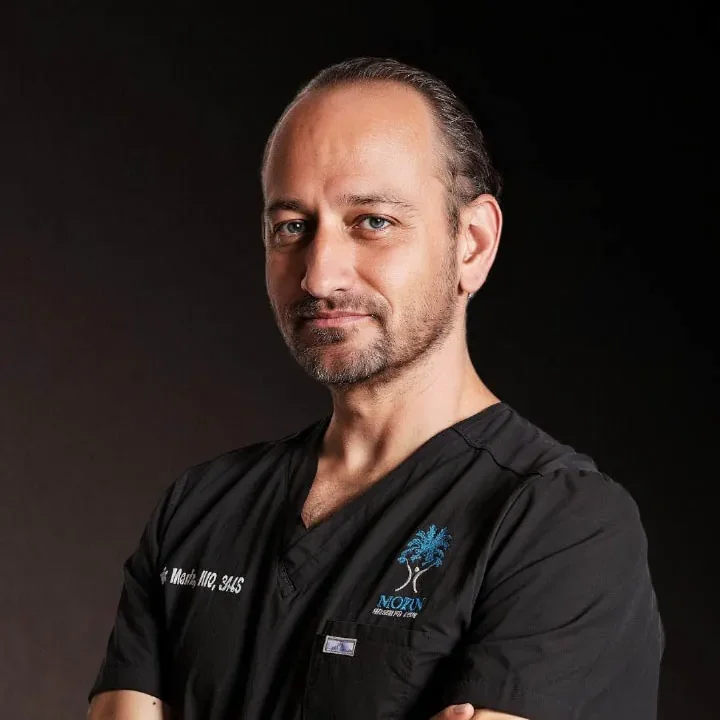Male nipple reduction surgeries have gradually escalated in their popularity, especially when men become conscious of the size and appearance of their nipples and nipple-areola complexes. Due to hormonal shifts, genetic factors, or even the effect of weight changes, men with protruding nipples often experience high levels of distress, further affecting their confidence. This in-depth resource will delve into every possible aspect related to male nipple reduction, including learning more about their anatomy, the surgical process, and recovery.

Why Do Men Have Nipples? Understanding Male Breast Anatomy
The question of “why do men have nipples?” is one of the most frequently searched terms related to the topic of the male body, and knowing the explanation has great significance with respect to nipple issues. Regardless of gender, all fetuses exhibit the same body pattern during embryonic development. Nipples appear in the first few weeks of development, even before the sex hormones kick in in the 7th week.
The formation of the mammary ridges and nipples occurs in both males and females. However, with the influence of the Y chromosome, which stimulates the secretion of testosterone and other male hormones, the developmental lines in males and females separate. While females develop breasts, which are lactation-capable, males also develop nipples, together with minimal development of their breasts.
This ‘leftover’ from evolution has nothing to do with the functional, sexually mature male, but is simply a reminder of our common ancestry. The nipple-areola complex in males is composed of essentially the same elements as in females, including the nipple, the pigmented surrounding skin called the areola, smooth muscle fibers that give rise to nipple erection, and nerve endings that provide sensation.
Male vs Female Nipple Differences: A Brief Comparison

Although structurally identical, there are significant differences between male and female nipples that can be identified during and after puberty. The nipples of females lie on top of the developed breast tissue, which is also higher on the chest. The nipples of females have larger areolas, which generally measure 3-4 centimeters in diameter, and may become pigmented during pregnancy.
Male nipples, on the other hand, tend to be flat against the chest with very small amounts of breast tissue. The normal diameter of the nipple-areola complex in males is 2-3 centimeters, with even pigmentation, which remains stable throughout one’s lifetime. However, such parameters tend to differ, and, in some instances, males could have enlarged nipple-areola complexes or nipples, which might cause them distress.
The positioning is also different, with the nipples in males ideally placed at the level of the fourth intercostal space, establishing the normal chest position. However, when this positioning gets altered by size and projection, it often produces a feminizing or even uncomfortable effect in males.
When Male Nipple Reduction Becomes Necessary?
Not all men with prominent nipples require surgical intervention, but for those experiencing physical discomfort or psychological distress, male nipple reduction can be life-changing. The decision to pursue surgery is highly personal and should be made after careful consideration and consultation with a qualified plastic or cosmetic surgeon.
Common Reasons Men Seek Nipple Reduction
Enlarged Areolas: Some men are born with or develop areolas that are disproportionately large for their chest size. This can create an unbalanced appearance that becomes particularly noticeable when wearing fitted clothing or during intimate situations.
Puffy Nipples: This condition, often related to mild gynecomastia, causes the nipple-areola complex to protrude from the chest. Even men with otherwise athletic builds may struggle with this localized puffiness that doesn’t respond to diet or exercise.
Post-Gynecomastia Concerns: Men who have undergone gynecomastia surgery may find that while their chest contour has improved, their nipples remain enlarged or positioned incorrectly. In fact, there are different grades of gynecomastia (Grade 1 through Grade 4), and nipple issues can persist even after successful breast tissue removal. Many surgeons now recommend addressing nipple concerns simultaneously with gynecomastia treatment for optimal results.
Asymmetry: Natural asymmetry between nipples is common, but when it becomes pronounced, it can be a source of self-consciousness. This might involve differences in size, shape, projection, or position between the two nipples.
Weight Loss Effects: Significant weight loss, whether through traditional methods or newer GLP-1 medications, can leave men with stretched areolas or nipples that appear out of proportion with their new, slimmer physique.
Male Nipple Reduction Procedure Explained

The surgical approach to male nipple reduction is tailored to each patient’s specific concerns and anatomy. Dr. Moein, a board-certified cosmetic surgeon in Los Angeles with extensive experience in male chest contouring, employs various techniques depending on the individual case.
Surgical Techniques
Circumferential Reduction: For men with enlarged areolas, this technique involves removing a ring of pigmented skin from the outer edge of the areola. The surrounding skin is then carefully sutured to the new areolar border, creating a smaller, more proportionate appearance. This method preserves nipple sensation and maintains a natural-looking result.
Wedge Excision: When the nipple itself is too prominent or long, a wedge of tissue can be removed from the nipple’s center. This reduces projection while maintaining the nipple’s circular shape and sensitivity.
Base Reduction: For nipples that are too wide at the base, tissue can be removed from around the circumference, creating a narrower, more refined appearance.
Combination Approaches: Many men benefit from a combination of techniques, addressing both areolar size and nipple projection in a single procedure. This comprehensive approach ensures balanced, natural-looking results.
The procedure typically takes 1-2 hours and can be performed under local anesthesia with sedation or general anesthesia, depending on the extent of correction needed and whether it’s combined with other procedures, such as gynecomastia surgery or Ab Etching.
| Nipple Characteristics | Average Male | Average Female | Ideal Male After Surgery |
|---|---|---|---|
| Areola Diameter | 2-3 cm | 3-4 cm | 2-2.5 cm |
| Nipple Projection | 2-4 mm | 8-10 mm | 2-3 mm |
| Position on Chest | 4th intercostal space | Variable with breast | 4th intercostal space |
| Typical Concerns | Size, projection | Symmetry, size | Proportionate & flat |
| Recovery Time | N/A | N/A | 3-5 days to work |
Why Do Men’s Nipples Become Enlarged?
Understanding the underlying causes of nipple enlargement can help men make informed decisions about treatment and set realistic expectations for outcomes.
Hormonal Influences
Hormonal imbalances, particularly an increase in estrogen relative to testosterone, can cause changes in nipple and areolar size. This can occur naturally during puberty, with aging, or as a side effect of certain medications. Anabolic steroid use like anvar, for example, can paradoxically lead to nipple enlargement due to the conversion of excess testosterone to estrogen.
Genetic Predisposition
Some men are simply born with larger nipples or areolas due to genetic factors. This familial trait often becomes apparent during adolescence and remains stable throughout adulthood unless influenced by other factors.
Weight Fluctuations
Significant weight gain can stretch the skin, including the areolar complex, leading to permanent enlargement even after weight loss. The recent surge in GLP-1 weight loss medications has led to an increase in men seeking nipple reduction after dramatic weight loss, as the skin doesn’t always retract proportionally.
Age-Related Changes
As men age, declining testosterone levels and changes in skin elasticity can affect nipple appearance. The areolas may appear to sag or enlarge, contributing to an aged appearance of the chest.
Cost and Financial Considerations
The cost of male nipple reduction varies depending on several factors, including the complexity of the procedure, geographic location, and whether it’s combined with other surgeries. In Los Angeles, where Dr. Moein practices, the procedure typically ranges from $3,000 to $6,000 when performed alone.
Insurance Coverage
Unfortunately, most insurance plans consider nipple reduction a cosmetic procedure and don’t provide coverage. However, when performed as part of gynecomastia surgery that meets medical necessity criteria, partial coverage may be available. Our office staff can help navigate insurance requirements and provide detailed information about coverage options specific to your plan.
Financing Options
Understanding that cost can be a barrier to treatment, many practices offer financing plans that allow patients to pay for their procedure over time. These medical financing options often feature low or no interest periods, making the surgery more accessible.
Choosing the Right Surgeon: Why Dr. Moein is Los Angeles’ Leading Male Nipple Reduction Expert
Selecting a qualified surgeon is crucial for achieving optimal results in male nipple reduction. Dr. Moein’s extensive experience in male chest contouring procedures, including hundreds of successful gynecomastia surgeries and nipple reductions, makes him the trusted choice for men throughout Southern California and beyond.
Why Experience Matters in Male Chest Surgery?
Male chest surgery requires a unique understanding of masculine aesthetics and the specific concerns men face. A surgeon experienced in these procedures knows how to create results that look natural and masculine, avoiding the feminized appearance that can result from inexperienced hands. Dr. Moein’s practice in Los Angeles has become a premier destination for men seeking expert chest contouring, with patients traveling from Beverly Hills, West Hollywood, Orange County, and even across the country for his specialized expertise.
His artistic eye, combined with advanced surgical techniques including VASER liposuction and precision nipple reduction methods, ensures results that enhance masculine chest contours while maintaining proportion and symmetry. With over a decade of experience specifically in male aesthetic surgery, Dr. Moein understands the unique psychological and physical aspects of treating male patients.
Taking the Next Step: Schedule Your Male Nipple Reduction Consultation in Los Angeles
If you’re considering male nipple reduction, the first step is scheduling a consultation with Dr. Moein at his Los Angeles practice. During this comprehensive appointment, your concerns will be thoroughly discussed, your anatomy carefully evaluated, and a customized treatment plan developed specifically for your needs.
Living with enlarged or prominent nipples doesn’t have to be a permanent source of distress. With modern surgical techniques and Dr. Moein’s experienced hands, achieving a masculine, confident chest appearance is more accessible than ever. Whether addressing isolated nipple concerns or combining treatment with comprehensive chest contouring, male nipple reduction can be a transformative procedure that significantly improves your quality of life.
Contact Dr. Moein Today for Your Private Consultation
Ready to take the first step toward the chest you’ve always wanted? Dr. Moein and his compassionate team are here to guide you through every step of your transformation journey.
Call us directly at: 310-896-4043
Our friendly patient coordinators are available Monday through Friday to answer your questions, discuss financing options, and schedule your confidential consultation. We understand that reaching out about intimate concerns requires courage, and we ensure every interaction is handled with the utmost discretion and professionalism.
Prefer to contact us online? Fill out our secure consultation request form and we’ll respond within 24 hours to arrange your appointment at a time that’s convenient for you.
.

Dr.Babak Moeinolmolki
LA Cosmetic Surgeon Dr. Moein is board-certified by the American Board of General Surgery.

